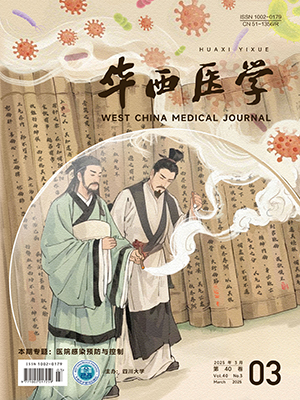【摘要】 目的 研究沙利度胺对人慢性粒细胞白血病急变株K562细胞凋亡及血管内皮生长因子(vascular endothelia growth factor,VEGF)分泌的影响。 方法 采用不同浓度的沙立度胺(0.5、1.0、2.0 mmol/L)作用于K562细胞24、48、72、96 h,瑞-姬(Wright-Giemsa)染色法观察细胞形态;四甲基偶氮唑盐(methylthiazolyl tetrozolium,MTT)法检测细胞增殖;流式细胞仪膜联蛋白V-异硫氰酸荧光素/碘化丙啶双染法检测凋亡率;琼脂糖凝胶电泳法检测脱氧核糖核酸梯状条带;酶联免疫吸附法检测VEGF浓度。 结果 培养24、48 h后,沙立度胺对K562细胞生长无抑制作用;作用72 h后,1.0、 2.0 mmol/L浓度组开始出现对K562细胞生长的抑制(P lt;0.001);作用96 h后,0.5 mmol/L浓度组也产生对K562细胞生长的抑制(P lt;0.001),呈一定的浓度和时间依赖性。沙立度胺处理72 h后,K562细胞出现形态学改变,其体积缩小,出现空泡化,边缘出现突起,染色质浓缩、边集,核固缩、出现凋亡小体。经沙立度胺处理后,流式分析结果显示K562细胞凋亡率增加(P lt;0.001)。沙立度胺作用72 h后,琼脂糖凝胶电泳可见典型的DNA梯状条带。K562细胞培养48 h后,沙立度胺抑制VEGF的分泌(P lt;0.001),并且VEGF浓度与凋亡率呈负相关(r=-0.789)。 结论 沙利度胺抑制K562细胞的增殖,呈一定的浓度和时间依赖性;沙利度胺对K562细胞凋亡有明显诱导作用;沙利度胺抑制K562细胞VEGF的分泌。
【Abstract】 Objective To investigate the effect of thalidomide on apoptosis of k562 cells and its vascular endothelial growth factor secretion. Methods K562 cells were cultured in vitro with 0.5, 1.0, and 2.0 mmol/L thalidomide for 24, 48, 72, and 96 hours. Morphology of the K562 cells was observed by the Wright-Giemsa staining method. Methylthiazolyl tetrozolium (MTT) assay was used to determine the cell growth. The rate of apoptosis was analyzed by flow cytometry (FCM) with annexin V-fluorescein isothiocyanate/propidium iodide (AnnexinV-FITC/PI)double-staining method. Agarose gel electrophoresis was used to detected Deoxyribonucleic acid Ladder(DNA Ladder). The concentration of VEGF was quantified by the enzyme-linked immunosorbent assay (ELISA). Results Cultured for 24 or 48 hours, thalidomide had no effect on the proliferation of the K562 cells. But after cultured for 72 hours, thalidomide began to inhibit the growth of the K562 cells at the concentration of 1.0 and 2.0 mmol/L (P lt;0.001). After cultured for 96 hours, the proliferation of the K562 cells was inhibited too at the concentration of 0.5 mmol/L thalidomide (P lt;0.001). Thus, thalidomide inhibited the growth of the K562 cells with a dose-and time-dependent manner to some extent. After exposure to thalidomide for 72 hours, K562 cells underwent typical morphological changes of apoptosis such as vaculization, the budding of cytoplasm, chromatin condensation, margination, shrunken nucleus and apoptotic body. The results of flow cytometry showed that thalidomide could obviously increase the rates of the apoptosis of K562 cells (P lt;0.001). After treated with thalidomide for 72 hours, DNA was extracted for Agarose gel electrophoresis and typical DNA ladder strips were observed. The secretion of VEGF was inhibited when exposure to thalidomide for 48 hours(P lt;0.001), and there was negative correlation between VEGF concentrations and apoptotic rates(r=-0.789). Conclusions Thalidomide could inhibite the growth of the K562 cells with a dose-and time-dependent manner to some extent. Thalidomide could obviously induce the apoptosis of the K562 cells and inhibit its secretion of VEGF.
Citation: ZHANG Yugao,HAN Liying,CHEN Feng,ZHAO Hua. Effect of Thalidomide on Apoptosis of K562 Cells and its Vascular Endothelial Growth Factor Secretion. West China Medical Journal, 2011, 26(9): 1298-1302. doi: Copy
Copyright © the editorial department of West China Medical Journal of West China Medical Publisher. All rights reserved




